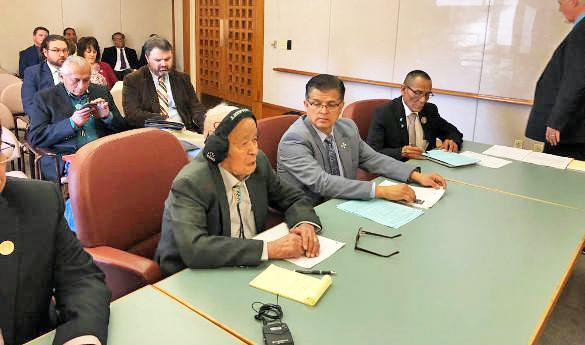 State Sen. John Pinto, 94, says he is one of about just eight Navajo Code Talkers who are still alive. Courtesy photo
State Sen. John Pinto, 94, says he is one of about just eight Navajo Code Talkers who are still alive. Courtesy photoBy ROBERT NOTT
They spoke a language most people — including many in their own nation — could not understand.
They befuddled their Japanese enemies who tried to make sense of the strange code. And when World War II ended, they knew they had played a part in keeping the world free.
“We helped win the war,” said Sen. John Pinto, 94, one of the few Navajo Code Talkers who’s still alive.
His voice choked with emotion and sadness when he spoke of his Navajo comrades who died during the war. But Pinto’s face flashed a wide grin when members of the Senate Indian and Cultural Affairs Committee voted unanimously Thursday to advance his bill to create a Navajo Code Talkers Museum and Veterans Center on Navajo land in McKinley County.
The measure, Senate Bill 365, has a long way to go to become law.
Pinto, D-Gallup, is requesting $1 million to build the museum. The site, close to the Arizona border, is the area that generated the majority of the Code Talkers.
“We used our indigenous language to win many battles and the war,” said Jonathan Nez, president of the Navajo Nation, in testifying for Pinto’s bill.
He said the museum will enable Navajo youth and people from around the world to understand the role Code Talkers played during the war.
Some of the Navajo men were as young as 15 when they enlisted. Some lied about their age when they signed up.
Before their emergence, the Japanese military proved adept at breaking American codes on troop movements in the South Pacific.
It got to the point, one historian of the Code Talkers once said, that the Japanese would then transmit radio messages to American forces that said, “Thank you very much for the information. We will be waiting for you.”
The Navajo’s Diné language was unwritten, and few non-Navajos knew it. So strategists created a code of more than 200 Diné words conveyed by Navajos serving in the Marines.
Japanese soldiers were baffled. So were the Allied forces and even the Navajos who were not taught the code.
“The enemy never understood what we were saying,” said Pinto, the longest-serving state senator, having been in office for 42 years.
He said as a child growing up in the American school system, he was spanked if he spoke his Native language. This made life all the more satisfying when he and other Code Talkers used the Navajo language to defeat the Japanese.
Pinto introduced a similar bill last year, but it died in the Senate. He said he is optimistic about its chances this year. New Mexico has more money because of a boom in oil, plus a new Democratic governor, giving him hope the museum will become a reality.
A financial analysis of his bill by the legislative staff said says costs for design and structure remain unknown. This “could limit the amount of funds that remain for the museum and veterans’ center structure,” the report states.
The bill next goes to the Senate Finance Committee, always a critical juncture for projects needing money.
 Navajo Code Talker Frank Chester Nez. Courtesy/U.S. Department of Defense
Navajo Code Talker Frank Chester Nez. Courtesy/U.S. Department of Defense Young Navajo Code Talkers on one of the Japanese-held islands in the Pacific. Courtesy/National Archives
Young Navajo Code Talkers on one of the Japanese-held islands in the Pacific. Courtesy/National Archives Navajo Code Talkers Henry Bake and George Kirk are shown in December 1943. Records of the U.S. Marine Corps, Record Group 127/via National Archives
Navajo Code Talkers Henry Bake and George Kirk are shown in December 1943. Records of the U.S. Marine Corps, Record Group 127/via National Archives
